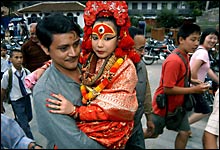Nepal's goddesses: religious abuse?
The Supreme Court will rule on whether a tradition of using children as living goddesses is a crime.
By Bikash Sangraula | Correspondent of The Christian Science Monitor
KATHMANDU, NEPAL – Receiving goddess-treatment in this Himalayan nation is not always as good as it may sound. The tradition of isolating and worshipping prepubescent girls as living goddesses - a practice that dates back centuries among Nepal's Newar community - has recently become controversial.
In a practice that is long believed to support Nepal's king, Buddhist girls as young as 4 years old have been selected in this kingdom to serve as Kumaris, the incarnations of the Hindu goddess Taleju.
But two petitions filed at Nepal's Supreme Court, one against and one in favor of the ritual, have placed Kumaris at the center of a tug of war between religion and human rights.
In a case filed in May 2005, lawyer Pun Devi Maharjan said the practice violates child rights and women's rights. In April 2006, Chunda Bajracharya, professor of culture at Tribhuvan University, the country's oldest, filed another petition demanding the tradition be preserved.
A committee, constituted in mid-November 2006 by a court order, will report by early February 2007 on whether the practice violates basic human rights.
But for most Newars, the indigenous ethnic group of the Kathmandu Valley, the practice of selecting girls from Buddhist families to represent the Hindu goddess Taleju is a symbol of unity between Hindus and Buddhists. While almost 80 percent Nepalese are Hindus, the country's more than 1 million Newars are both Hindu and Buddhist.
Twelve goddesses today
There are currently 12 sitting Kumaris, a word that means "virgin" in Nepali. But it is the Kumari of Basantapur who is the most important of all the worshiped virgins. She is worshiped by the king of Nepal and is believed to bestow strength on his monarchy.
A committee of Buddhist priests selects each Kumari through a process that begins once a young candidate has lost her first baby tooth. The Kumari's time in the spotlight is short: She must abdicate immediately after her first menstruation. At that point, the Kumari is expected to transition back to a normal childhood. .
The debate and its implications have hardly impressed Rashmila Shakya, who was a principal Kumari from 1984 to 1992. Being worshiped as a living goddess, Ms. Shakya says, was a privilege.
"It was fun. No one was mad at me. I didn't have to work either. I spent my days playing with dolls," Shakya says in her freshly cemented four-story house in central Kathmandu.
But when asked about the court case, her answer is just as simple: "That's politics. I don't want to get into that." Soft-spoken and shy, Shakya says she feels fortunate to have experienced both the lives of a goddess and a mortal. Her only regret is that she was not able to receive a formal education. "I used to get books used in the school curriculum. But there was no one pushing me to study, and I didn't sit for exams either," she says.
During her Kumari years, Shakya was allowed to meet with her biological family several times a year. She liked living with her caretaker family despite having to always wear makeup and the stiff, formal gown of the goddess.
After returning home in 1992 at the age of 12, she found the transition difficult. But a meeting with another former Kumari - a decade after returning to society - deepened her resolve to lead a normal, educated life. "I saw her sitting in her room, quietly, all made-up the way we used to be at the Kumari House. She still believed she was a goddess," she says. "I told myself this is not the way I am going to spend the rest of my life."
At the age of 26, Shakya recently took her final exams to receive her Bachelor of Science in Information Technology at a college in Kathmandu.
How the practice began
Historians say the living goddess practice dates back to the 17th-century reign of Kathmandu's King Pratap Malla. Legend has it that the king used to play dice in secret with the goddess Taleju. One night, when lustful thoughts entered the king's mind, Taleju vanished. Later, she appeared to the king in a dream and told him to select a young Buddhist girl who would bless the king with the strength to rule.
Every year, during the Indra Jatra festival, the reigning monarch receives the auspicious tika on his forehead from the principal Kumari and takes her sword in a ritual that is believed to give the king the power to rule for another year.
The Kumari tradition will face a tough test in 2007 because the fate of Nepal's monarchy is now at the mercy of a soon-to-be-elected special assembly. In addition to what the court decides, Kumari believers will be watching to see whether the goddess is able to protect Nepal's monarchy.
Lawyer Maharjan's main concern, she says, is that the tradition denies a normal childhood to young girls. "The education given to them is a sham. They are separated from parents. The meager salary they get goes to the caretakers," she says. In her petition, Ms. Maharjan demands that the tradition continue but only after ensuring that the "best interest" of the girls is protected.
Dr. Bajracharya, like Maharjan, is a member of the committee convened to advise the Supreme Court. Both women belong to the Newar community. "This is an attack on religious freedom," says Bajracharya. "Even if the court rules that it violates human rights, the tradition will continue. These are things that can only be reformed, not stopped."

